| Part of a series on |
| Ancient Egyptian religion |
|---|
 |

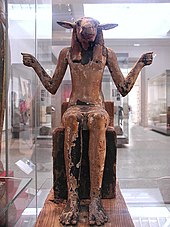
The gate deities of the underworld were ancient Egyptian minor deities charged with guarding the gates of the Egyptian underworld. [2] [3] [4]
| Part of a series on |
| Ancient Egyptian religion |
|---|
 |


The gate deities of the underworld were ancient Egyptian minor deities charged with guarding the gates of the Egyptian underworld. [2] [3] [4]
The Egyptians believed that in the netherworld, the Duat, there were various gates, doors and pylons crossed every night by the solar boat (Atet) of the sun-god Ra and by the souls directed to the world of the dead. [4]
Ancient funerary texts provide many different descriptions of the afterlife gates. Sometimes more than 1,000 guardian deities are listed. [3] According to a more general view, every gate was guarded by a minor god who allowed access only to the souls capable of pronouncing the secret name of the god himself, as a sort of "password". [3] The walls of many Pharaonic tombs in the Valley of the Kings are decorated with the texts of the Book of Gates, which describes the twelve gates or pylons of the underworld: in spite of being imagined as architectural barriers to all intents and purposes, the gates were individually named as goddesses. [4] Chapter 144 of the Book of the Dead mentions seven gates, each with its own God, a Doorkeeper and a Herald: for example, the 7th gate is guarded by the god "Sharpest Of Them All", by the doorkeeper "Strident Of Voice" and by the herald "Rejector Of Rebels". [3]
Other funerary texts mention 21 "Secret Portals Of The Mansion Of Osiris In The Field Of Reeds" with their own names and epithets and protected by zoo-anthropomorfic deities often depicted crouched on the ground and holding large, threatening knives. [3] The names of these last accesses — still feminine — are from time to time disturbing as the 14th ("Mistress Of Anger – Dancing On Blood") or harmless as the 3rd ("Mistress Of The Altar"). The guardian-gods too were given names that inspired terror and, above all, evoked their fearful powers: for example "Swallower Of Sinners" and "Existing On Maggots" — even if some texts avoided directly indicating their names, adding these largely unnamed gate deities of the underworld to the group of Egyptian divinities known to scholars, but impossible to inventory. [3]
According to the descriptions provided by the wall paintings in regal tombs of the Valley of the Kings, each gate or pylon consisted of three elements: a) a spitfire snake placed in front of the access, b) the gate itself, described both as a true architectural portal and as a goddess, c) and its guardian deities. The solar boat's travel through such gates can be described as follows. [2]

1st gate: Sia (deification of perception) [5] standing on the prow of the sun boat, invites a snake called "Desert-Protector" to unlock the gate to the arrival of Ra who, in the form of the god Atum (deification of the sunset sun [6] ), observes his enemies being massacred.
2nd gate: the guardian god is called "Swallower Of Sinners" and his gate precedes a lake of fire.
3rd gate: its guardian snake is "Stinger" while the portal itself is the goddess "Mistress Of Food"; some jackals watch over the "Lake of Life" interdicted to the dead because it is the place where Ra draws his breath.

4th gate: some deities carry ropes to measure the extension of the netherworld fields — as well as, in the daily life of the Egyptians, the measurement of the fields was carried out for tax purposes; this is also where the four human ethnic groups (according to the Egyptians) were depicted: the "cattle of Ra", i.e. Egyptians themselves, Levantines, Libyans, and Nubians.
5th gate: this gate is the goddess "Lady Of Duration" while its guardian serpent is "Flame-Eyed"; this access is inhabited by the perfidious demon Apep — embodiment of evil and chaos (Isfet), bitter enemy of Ra [7] — here called "Evil Of Face". 20 deities manage to stem his devastating power by continuing to dissect it, while the heads of those he devoured emerge from his coils. The sun boat moves on and Ra leaves this dramatic region.
6th gate: Ra's boat approaches to seven jackal-headed poles with two enemies bound to each one, waiting to be beheaded.
7th gate: this gate is the goddess "Shining One" and beyond it there are 20 gods holding a rope ending in four whips, four falcon heads and four human heads. This is an enigmatic and barely understandable point.
8th gate: this access is inhabited by a flaming snake who burns up the enemies of Osiris.
9th gate: here stand Horus and Set on a hawk-headed lion.
10th gate: Apep appears again, but chained in order not to harm Ra in his transit.
11th gate: this gate is called "Mysterious Of Approaches" and is overseen by the cat-headed god Meeyuty ( meow onomatopoeia).
12th gate: here stand the goddesses Isis and Nephthys in the form of snakes: the journey through the gates of the afterlife is finished and the sun rises on the world in the form of a sacred scarab (Khepri, deification of the morning sun [8] ).
The British Egyptologist George Hart thus outlined, in his Dictionary of Egyptian Gods and Goddesses (1986), the evocative names of these deities and their positions in the netherworld as described in the funeral papyri known to scholars: [9]
| Gate | God | Title | Doorkeeper | Herald |
|---|---|---|---|---|
| 1 | "Upside Down Of Face – Manifold Of Forms" | "Secret Listener" | "Miserable Of Voice" | |
| 2 | "Stretched Out Of Forehead" | "Seqed (?) Faced" | "Glowing" | |
| 3 | "Eater Of The Foulness From His Hindquarters" | "Watchful Of Face" | "Curser" | |
| 4 | "Hostile Of Face – Loquacious" | "Perceptive" | "Great Of Face – Crocodile-Repeller" | |
| 5 | "Existing On Maggots" | "Ashbu" | "Hippopotamus Face – Furious Of Onslaught" | |
| 6 | "Raging Of Voice" | "Face-Eraser" | "Sharp Of Face" | |
| 7 | "Sharpest Of Them" | "Strident Of Voice" | "Rebuffing Insurgents" |
| Portal | Name of Portal as Goddess | Guardian God |
|---|---|---|
| 1 | "Mistress Of Trembling" | "Dreadful" |
| 2 | "Mistress Of The Sky" | "Born Of The Hindquarters" |
| 3 | "Mistress Of The Altar" | "Cleanser" |
| 4 | "Powerful Of Knives" | "Long-Horned Bull" |
| 5 | "Fiery One" | "Killer Of Opponents" |
| 6 | "Mistress Of Darkness" | "Destroyer" |
| 7 | "Veiler Of The Weary One (Osiris)" | "Ikenti" |
| 8 | "Lighter Of Flames – Extinguisher Of Heat" | "Protector Of His Body" |
| 9 | "Foremost" | "Fowler" |
| 10 | "Piercing Of Voice" or "High Of Double Doors" | "Great Embracer" |
| 11 | "Ceaseless In Knifing – Scorcher Of Rebels" | "Cook Of His Braziers" |
| 12 | "Invoked By Her Two Lands" | "Cat" |
| 13 | "She Above Whom Osiris (or: Isis, Ennead) Stretches His Arms" | "Destroyer Of The Robber" |
| 14 | "Mistress Of Anger – Dancing On Blood" | "Screecher" |
| 15 | "Great Of Valour" | "Vigilant Of Face" |
| 16 | "Dread" | "Clever In Bowing" |
| 17 | "Great On The Horizon" | "Spirit" |
| 18 | "Lover Of Heat" | "Anointed" |
| 19 | "She Who Foretells Mornings Throughout Her Lifespan – Possessor Of The Writings of Thoth" | nameless |
| 20 | "Dweller Within the Cavern Of Her Lord" | nameless |
| 21 | "Sharpener Of Flint To Speak For Her" | "Giraffe" ("Memy") |
Ancient Egyptian religion was a complex system of polytheistic beliefs and rituals that formed an integral part of ancient Egyptian culture. It centered on the Egyptians' interactions with many deities believed to be present and in control of the world. About 1500 deities are known. Rituals such as prayer and offerings were provided to the gods to gain their favor. Formal religious practice centered on the pharaohs, the rulers of Egypt, believed to possess divine powers by virtue of their positions. They acted as intermediaries between their people and the gods, and were obligated to sustain the gods through rituals and offerings so that they could maintain Ma'at, the order of the cosmos, and repel Isfet, which was chaos. The state dedicated enormous resources to religious rituals and to the construction of temples.

Horus, also known as Heru, Har, Her or Hor in Ancient Egyptian, is one of the most significant ancient Egyptian deities who served many functions, most notably as god of kingship, healing, protection, the sun and the sky. He was worshipped from at least the late prehistoric Egypt until the Ptolemaic Kingdom and Roman Egypt. Different forms of Horus are recorded in history, and these are treated as distinct gods by Egyptologists. These various forms may be different manifestations of the same multi-layered deity in which certain attributes or syncretic relationships are emphasized, not necessarily in opposition but complementary to one another, consistent with how the Ancient Egyptians viewed the multiple facets of reality. He was most often depicted as a falcon, most likely a lanner falcon or peregrine falcon, or as a man with a falcon head.

Atum, sometimes rendered as Atem or Tem, is the primordial god in Egyptian mythology from whom all else arose. He created himself and is the father of Shu and Tefnut, the divine couple, who are the ancestors of the other Egyptian deities. Atum is also closely associated with the evening sun. As a primordial god and as the evening sun, Atum has chthonic and underworld connections. Atum was relevant to the ancient Egyptians throughout most of Egypt's history. He is believed to have been present in ideology as early as predynastic times, becoming even more prevalent during the Old Kingdom and continuing to be worshiped through the Middle and New Kingdom, though he becomes overshadowed by Re around this time.

Apep, also spelled Apepi, Aapep, or Apophis, was the ancient Egyptian deity who embodied darkness and disorder, and was thus the opponent of light and Ma'at (order/truth). He appears in art as a giant serpent. Apep was first mentioned in the Eighth Dynasty, and he was honored in the names of the Fourteenth Dynasty king 'Apepi and of the Greater Hyksos king Apophis.

The Duat is the underworld in ancient Egyptian mythology. It has been represented in hieroglyphs as a star-in-circle: 𓇽. The god Osiris was believed to be the lord of the underworld. He was the first mummy as depicted in the Osiris myth and he personified rebirth and life after death. The underworld was also the residence of various other gods along with Osiris.

Nehebkau was the primordial snake god in ancient Egyptian mythology. Although originally considered an evil spirit, he later functions as a funerary god associated with the afterlife. As one of the forty-two assessors of Ma’at, Nehebkau was believed to judge the deceased after death and provide their souls with ka – the part of the soul that distinguished the living from the dead.

Hathor was a major goddess in ancient Egyptian religion who played a wide variety of roles. As a sky deity, she was the mother or consort of the sky god Horus and the sun god Ra, both of whom were connected with kingship, and thus she was the symbolic mother of their earthly representatives, the pharaohs. She was one of several goddesses who acted as the Eye of Ra, Ra's feminine counterpart, and in this form she had a vengeful aspect that protected him from his enemies. Her beneficent side represented music, dance, joy, love, sexuality, and maternal care, and she acted as the consort of several male deities and the mother of their sons. These two aspects of the goddess exemplified the Egyptian conception of femininity. Hathor crossed boundaries between worlds, helping deceased souls in the transition to the afterlife.

Mafdet was a goddess in the ancient Egyptian religion. She was often depicted wearing a skin of a cheetah, and protected against the bite of snakes and scorpions. She was part of the ancient Egyptian deities that was during the First Dynasty of Egypt. She was prominent during the reign of pharaoh Den whose image appears used to appear on stone vessel fragments from his tomb and is mentioned in a dedicatory entry in the Palermo Stone. Mafdet was the deification of legal justice, or possibly of capital punishment. She was associated with the protection of the king's chambers and was other sacred places, and was with protection against venomous animals, which was seen as transgressors against Maat. In the was Pyramid Texts of the Old Kingdom of Egypt, she was mentioned as protecting the sun god Ra from venomous snakes.

Meretseger was a Theban cobra-goddess in ancient Egyptian religion, in charge with guarding and protecting the vast Theban Necropolis — on the west bank of the Nile, in front of Thebes — and especially the heavily guarded Valley of the Kings. Her cult was typical of the New Kingdom of Egypt.
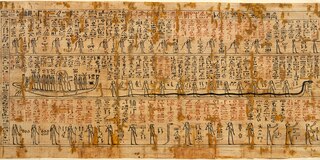
The Amduat is an important ancient Egyptian funerary text of the New Kingdom of Egypt. Like many funerary texts, it was found written on the inside of the pharaoh's tomb for reference. Unlike other funerary texts, however, it was reserved only for pharaohs or very favored nobility.

The Eye of Ra or Eye of Re is a being in ancient Egyptian mythology that functions as a feminine counterpart to the sun god Ra and a violent force that subdues his enemies. The eye is an extension of Ra's power, equated with the disk of the sun, but it often behaves as an independent goddess. This goddess can be equated with several particular deities, including Hathor, Sekhmet, Bastet, Raet-Tawy, and Mut. The eye goddess acts as mother, sibling, consort, and daughter of the sun god. She is his partner in the creative cycle in which he begets the renewed form of himself that is born at dawn. The eye's violent aspect defends Ra against the agents of disorder that threaten his rule. This dangerous aspect of the eye goddess is often represented by a lioness or by the uraeus, or cobra, a symbol of protection and royal authority. The Eye of Ra is similar to the Eye of Horus, which represents many of the same concepts. The disastrous fury and rampages of the eye goddess and the efforts of the gods to appease her are a prominent motif in Egyptian mythology.
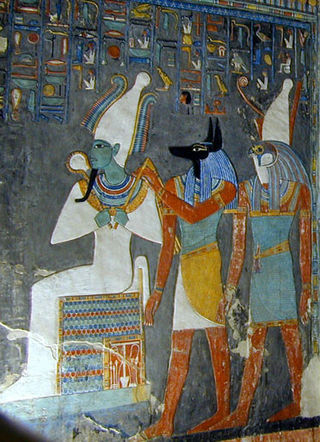
Ancient Egyptian deities are the gods and goddesses worshipped in ancient Egypt. The beliefs and rituals surrounding these gods formed the core of ancient Egyptian religion, which emerged sometime in prehistory. Deities represented natural forces and phenomena, and the Egyptians supported and appeased them through offerings and rituals so that these forces would continue to function according to maat, or divine order. After the founding of the Egyptian state around 3100 BC, the authority to perform these tasks was controlled by the pharaoh, who claimed to be the gods' representative and managed the temples where the rituals were carried out.
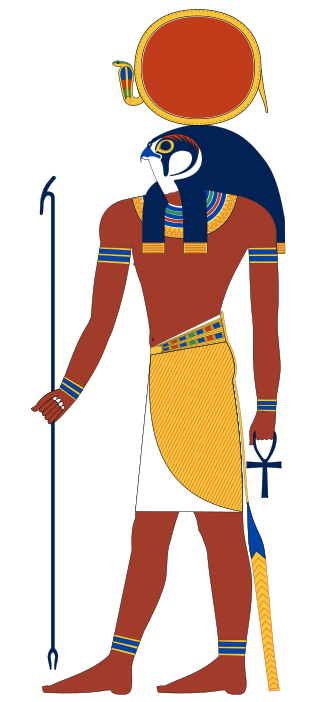
Ra or Re was the ancient Egyptian deity of the Sun. By the Fifth Dynasty, in the 25th and 24th centuries BC, he had become one of the most important gods in ancient Egyptian religion, identified primarily with the noon-day sun. Ra ruled in all parts of the created world: the sky, the Earth, and the underworld. He was believed to have ruled as the first pharaoh of Ancient Egypt. He was the god of the sun, order, kings and the sky.

Egyptian mythology is the collection of myths from ancient Egypt, which describe the actions of the Egyptian gods as a means of understanding the world around them. The beliefs that these myths express are an important part of ancient Egyptian religion. Myths appear frequently in Egyptian writings and art, particularly in short stories and in religious material such as hymns, ritual texts, funerary texts, and temple decoration. These sources rarely contain a complete account of a myth and often describe only brief fragments.

Ancient Egyptian creation myths are the ancient Egyptian accounts of the creation of the world. The Pyramid Texts, tomb wall decorations, and writings, dating back to the Old Kingdom have provided the majority of information regarding ancient Egyptian creation myths. These myths also form the earliest religious compilations in the world. The ancient Egyptians had many creator gods and associated legends. Thus, the world or more specifically Egypt was created in diverse ways according to different parts of ancient Egypt. Some versions of the myth indicate spitting, others masturbation, as the act of creation. The earliest god, Ra and/or Atum, emerged from a chaotic state of the world and gave rise to Shu (air) and Tefnut (moisture), from whose union came Geb (earth) and Nut (sky), who in turn created Osiris, Isis, Set, and Nephthys. An extension to this basic framework was the Osiris myth involving Osiris, his consort Isis, and their son Horus. The murder of Osiris by Set, and the resulting struggle for power, won by Horus, provided a powerful narrative linking the ancient Egyptian ideology of kingship with the creation of the cosmos.

Solar barques were the vessels used by the sun god Ra in ancient Egyptian mythology. During the day, Ra was said to use a vessel called the Mandjet or the Boat of Millions of Years, and the vessel he used during the night was known as the Mesektet.
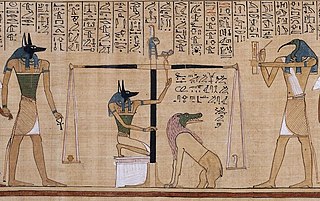
Ancient Egyptian afterlife beliefs were centered around a variety of complex rituals that were influenced by many aspects of Egyptian culture. Religion was a major contributor, since it was an important social practice that bound all Egyptians together. For instance, many of the Egyptian gods played roles in guiding the souls of the dead through the afterlife. With the evolution of writing, religious ideals were recorded and quickly spread throughout the Egyptian community. The solidification and commencement of these doctrines were formed in the creation of afterlife texts which illustrated and explained what the dead would need to know in order to complete the journey safely.

The Cavern deities of the underworld were ancient Egyptian minor deities charged with punishing the damned souls by beheading and devouring them.
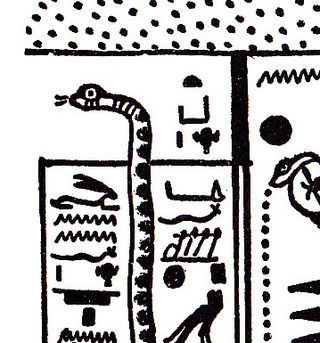
Teka-her, literally "He with the enlightened face", is a monstrous serpent from Egyptian mythology. His existence is mentioned in the Book of Gates, a composition reserved for New Kingdom pharaohs and inscribed in their tombs. Guardian god and protector, Teka-her is one of the many beings whose task it is to ensure the safety of the Duat, the underworld of the dead. More specifically, he watches over the doorway of the Fourth Hour of the Night, in the company of Tekmy and Amou, jackal-headed mummiform gods. According to Egyptian mythology, during the twelve hours of the night, Ra, the solar god, travels through this inframundum in a boat. At each hourly change, the boat arrives at a gate closely guarded by a cohort of beneficent demons. Their primary role is to destroy the damned souls - Osiris' enemies. With his divine and luminous power, Ra naturally convinces the demons to let him pass.